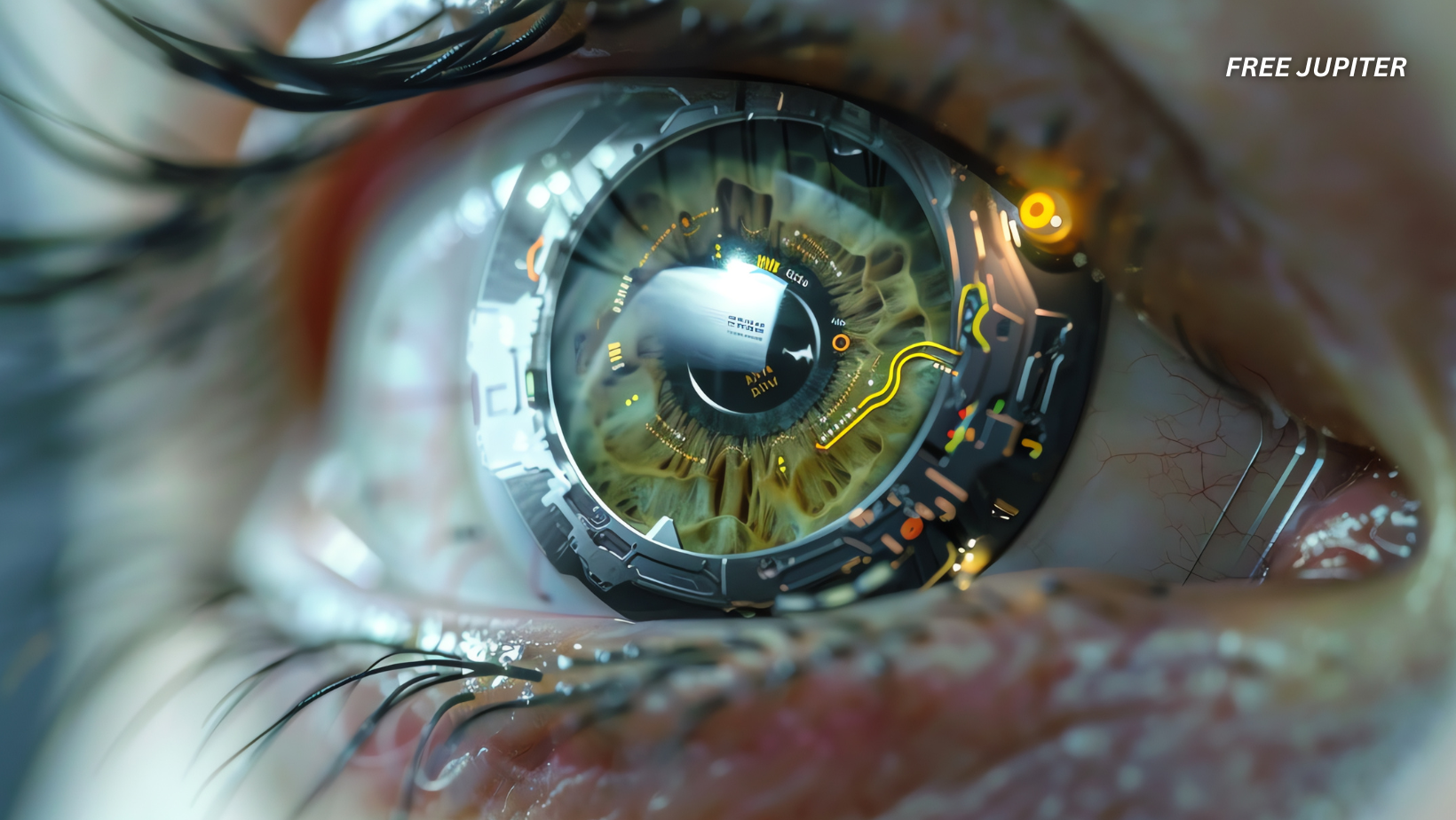Imagine losing your sight not because your brain can’t process images, but because the “front window” of your eye—the cornea—has become cloudy or scarred. For millions of people worldwide, that’s exactly the case. Until now, the main solution has been a corneal transplant, which depends on donor tissue. But donor corneas are in short supply, and even when surgery is successful, some patients remain legally blind.
A team of researchers and companies are now proposing something that feels like it belongs in a sci-fi novel: an electronic implant that beams images directly to the retina, skipping over the damaged cornea entirely. If all goes according to plan, human trials could begin within just two years.
Why the Cornea Matters
The cornea is the clear dome-shaped surface at the very front of the eye. Think of it as a biological window: light passes through it, bends, and lands precisely on the retina at the back of the eye. Without this first step, the rest of the visual system can’t do its job.
Unfortunately, the cornea is fragile. It can be damaged by infections, injuries, or diseases such as keratoconus (where the cornea thins and bulges), as well as scarring after trauma. When this happens, light can’t pass through properly, leaving people with cloudy or severely blurred vision.
Globally, over 12 million people live with corneal blindness. In high-income countries, corneal transplants have helped many regain some vision, but the surgery is complex, expensive, and limited by donor availability. Only around 185,000 corneal transplants are performed each year—far fewer than the number of patients who need them. And even then, not every transplant results in restored sight. Some patients end up legally blind, trapped between hope and disappointment.
Read more: New Infrared Contacts Let You See in the Dark — Even With Your Eyes Shut
A New Workaround: Beaming Images Straight to the Retina
Enter a collaboration between Xpanceo, a Dubai-based deep-tech company, and Intra-Ker, an Italian startup. Together, they’ve unveiled the first successful proof-of-concept for what they call an intracorneal implant—a device designed not to fix the cornea, but to bypass it altogether.
Here’s the clever twist: instead of relying on light passing through a damaged cornea, the implant projects visual information directly onto the retina. The process looks like this:
- Smart Glasses Capture the World
Special external glasses with a built-in camera record the wearer’s surroundings. - Wireless Transmission
The glasses wirelessly transmit that visual feed to the implant inside the eye. This system borrows from Xpanceo’s work on experimental smart contact lenses, which already use wireless communication for power and data transfer. - A Tiny Projector Inside the Eye
A sealed, sesame-seed–sized display (5.6 mm across) with a resolution of 450×450 pixels beams images directly onto the retina.
The damaged cornea becomes irrelevant. As long as the retina and brain are healthy, the implant delivers the “signal” of vision directly to where it’s needed.
Professor Massimo Busin, President and CEO of Intra-Ker, put it this way: “Until now, implanting electronics in the front part of the eye has not been successful. This system opens a new path because it doesn’t rely on donor tissue, and the surgery is no more complex than a typical corneal procedure.”
How This Differs From Other Vision Restorations
This isn’t the first attempt to restore vision using technology. In fact, researchers have been experimenting with bionic eyes and retinal implants for decades. Those devices generally try to stimulate the retina or even the brain’s visual cortex directly, but results so far have been limited to rudimentary “pixelated” vision—enough to detect outlines or light sources but not much detail.
The new corneal-bypass implant takes a different approach. Rather than trying to “recreate” vision inside the brain, it simply reroutes the pathway that’s blocked. Think of it as a detour road: the main highway (cornea) is closed, so the implant builds a new connection to the retina. The technology is less about replacing biology and more about engineering a shortcut.
The Human Side of Corneal Blindness
For people living with corneal blindness, daily life can feel like looking through frosted glass. Imagine trying to recognize a friend’s face, cross a street, or read a sign when everything looks foggy and indistinct. Glasses or contact lenses don’t help because the problem isn’t focus—it’s that light itself can’t pass through.
Patients often describe the frustration of being dependent on others for basic tasks. Even with corneal transplants, outcomes are unpredictable, and many live with the anxiety of graft rejection or surgery failure. A solution that doesn’t depend on donor tissue could be transformative—not just medically, but emotionally and socially.
Read more: A Rare Genetic Mutation Gave This Indonesian Tribe Electric Blue Eyes
Why This Matters
The potential benefits of this technology ripple far beyond the lab:
- Freedom From Donor Shortages: With millions waiting for corneal transplants and only a fraction receiving them, bypassing donor tissue solves a fundamental bottleneck.
- Restored Independence: For patients who are legally blind, even partial vision restored by the implant could mean reading, navigating streets, or simply seeing loved ones again.
- Scalability: Unlike corneal tissue, which must be donated and carefully preserved, electronics can be manufactured and distributed globally. This could make treatment more accessible and eventually more affordable.
Dr. Valentyn Volkov, founder of Xpanceo, captured the scale of this breakthrough: “With over 12 million people awaiting corneal transplants, we see this as the beginning of a new era, where advanced optics and computation can bridge longstanding gaps in vision care.”
Other Paths in Vision Science
This futuristic implant is part of a larger wave of innovation in eye care. Researchers around the world are exploring different strategies:
- Smart Contact Lenses: Being developed to project augmented reality information or even monitor health indicators like glucose levels.
- Stem Cell Therapies: Aimed at regenerating damaged retinal tissue and potentially restoring natural vision.
- Gene Therapy: Already being trialed for certain rare inherited forms of blindness, with promising results.
What makes the corneal-bypass implant stand out is its practicality. It doesn’t require rewriting DNA or regrowing tissue—it works with what patients already have, using engineering to fill in the missing step.
What’s Next?
The proof-of-concept used a 450×450-pixel display, but the long-term goal is to miniaturize the system for comfort and stability. The device also needs to pass rigorous safety and regulatory checks before it can reach patients.
If all goes well, human trials could begin within two years. Market analysts estimate its potential market at $50 million to $200 million annually, though for patients, the true value is far more personal: the chance to see again.
A Glimpse Into the Future
The idea of skipping over the cornea and beaming vision directly to the retina feels almost like science fiction. But for millions who may never receive a donor transplant, this could become everyday medicine.
If the technology works as intended, eyesight in the 21st century may no longer depend solely on biology. Instead, it could be a partnership between nature and microelectronics—an engineered solution to one of humanity’s oldest challenges.
Final Thought
The journey from blurred shadows to clear sight has always been a mix of hope, patience, and scientific ingenuity. While donor transplants have given many people a second chance at vision, millions are still waiting in the dark. This new implant doesn’t just offer a technological fix—it represents a profound shift in how we think about medicine itself. Instead of repairing broken parts the old-fashioned way, we may soon be redesigning entirely new pathways to restore what was once thought permanently lost.
If successful, this breakthrough will remind us of something powerful: the future of healthcare isn’t only about saving lives—it’s also about restoring the fullness of living.
Featured image: Freepik.
Friendly Note: FreeJupiter.com shares general information for curious minds. Please fact-check all claims and double-check health info with a qualified professional. 🌱










